 W
WA food paste is a semi-liquid colloidal suspension, emulsion, or aggregation used in food preparation or eaten directly as a spread. Pastes are often highly spicy or aromatic, are often prepared well in advance of actual usage, and are often made into a preserve for future use. Common pastes are some fruit preserves, curry pastes, and nut pastes. Purées are food pastes made from already cooked ingredients.
 W
WThis is a list of notable food pastes. A food paste is a semi-liquid colloidal suspension, emulsion, or aggregation used in food preparation or eaten directly as a spread. Pastes are often spicy or aromatic, prepared well in advance of actual usage, and are often made into a preserve for future use. Common pastes are curry pastes, fish pastes, some fruit preserves, legume pastes and nut pastes. Purées, however, are food pastes made from already cooked ingredients, as in the case of cauliflower purée, or raw, as in the case of apple purée.
 W
WAlmond butter is a food paste made from grinding almonds into a nut butter. Almond butter may be "crunchy" or "smooth", and is generally "stir" or "no-stir" (emulsified). Almond butter may be either raw or roasted, but this describes the almonds themselves, prior to grinding. It is recommended that almond butter be refrigerated once opened to prevent spoilage and oil separation.
 W
WAlmond paste is made from ground almonds or almond meal and sugar in equal quantities, with small amounts of cooking oil, beaten eggs, heavy cream or corn syrup added as a binder. It is similar to marzipan, but has a coarser texture. Almond paste is used as a filling in pastries, but it can also be found in chocolates. In commercially manufactured almond paste, ground apricot or peach kernels are sometimes added to keep the cost down.
 W
WAnchovy paste is a fish paste food product prepared using anchovies as a primary ingredient. It is used as a condiment and as an ingredient in various dishes, such as Scotch woodcock, and is a mass-produced product. It has been used for centuries to provide flavor to foods and as a source of nutrients, and it is a part of the cuisines of Great Britain, Italy, the Philippines and Vietnam. It is a major export product of Morocco.
 W
WAussieMite is an Australian savoury food spread made from vegetable protein and yeast extract with various vitamins and minerals such as B vitamins and Iron. It was founded by Roger Ramsey in 2001. The taste of the product is slightly salty and is used for toast, sandwiches, crumpets and cracker biscuits, as well as a filling for pastry products.
 W
WSalça is a category of thick, deep red paste made from peppers or tomato and salt, originating from Turkey.
 W
WBiłgoraj pierogi - traditional Polish regional dish, originating from Biłgoraj Land, formerly prepared for important celebrations and holidays.
 W
WBurmese curry refers to a diverse array of dishes in Burmese cuisine that consist of protein or vegetables simmered or stewed in an curry base of aromatics. Burmese curries generally differ from other Southeast Asian curries in that Burmese curries make use of dried spices in addition to fresh herbs and aromatics, and are often milder. Burmese curries are readily available in curry houses throughout the country. They are traditionally accompanied with rice and a variety of side dishes, soup, and Burmese salads called athoke. Burmese curries may also be paired with flatbreads like nanbya, palata, aloo puri, and toshay.
 W
WCashew butter is a food spread made from baked or roasted cashews. It is rich and creamy in flavour and when stored the oils and solids separate easily.
 W
WCenovis is a dark brown food paste consisting of yeast extract. It is similar to English Marmite, Brazilian Cenovit, and Australian Vegemite. It is rich in vitamin B1. It is used to flavour soups, sausages and salads. The most popular way to consume Cenovis, however, is to spread it on a slice of buttered bread, as stated on the product's packaging (or it can be blended into the butter and spread on bread or as a filling in croissants and buns).
 W
WCheonggukjang is a traditional Korean food made by fermenting soybeans. It contains whole, as well as ground soybeans.
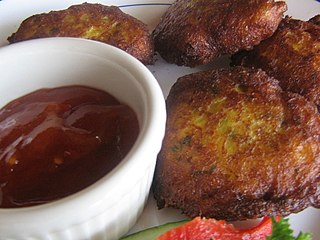 W
WChili sauce and chili paste are condiments prepared with chili peppers.
 W
WChopped liver is a liver pâté popular in Ashkenazic cuisine. This dish is a common menu item in kosher Jewish delicatessens in Britain, Canada, South Africa, and the United States.
 W
WCookie butter is a food paste made primarily from speculoos cookie crumbs, fat, flour, and sugar. The ingredients are mixed until it becomes spreadable on a sandwich. In countries like Belgium, the Netherlands, and France, it is a common alternative to nut butter and chocolate spreads. The most common brand name is Lotus Bakeries.
 W
WDoenjang or soybean paste is a type of fermented bean paste made entirely of soybean and brine. It is also a byproduct of soup soy sauce production. It is sometimes used as a relish.
 W
WFermented bean paste is a category of fermented foods typically made from ground soybeans, which are indigenous to the cuisines of East, South and Southeast Asia. In some cases, such as the production of miso, other varieties of beans, such as broad beans, may also be used.
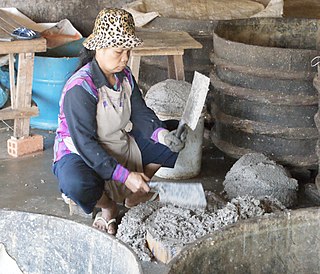 W
WFish paste is fish which has been chemically broken down by a fermentation process until it reaches the consistency of a soft creamy purée or paste. Alternatively it refers to cooked fish which has been physically broken down by pounding, grinding, pressing, mincing, blending, and/or sieving, until it reaches the consistency of paste. The term can be applied also to shellfish pastes, such as shrimp paste or crab paste.
 W
WFondant icing, also commonly referred to simply as fondant, is an icing used to decorate or sculpt cakes and pastries. It is made from sugar, water, gelatin, vegetable fat or shortening, and glycerol. It does not have the texture of most icings; rolled fondant is akin to stiff clay, while poured fondant is a thick liquid. The word, in French, means "melting," coming from the same root as fondue and foundry.
 W
WGentleman's Relish is a British commercial brand of anchovy paste. It is also known as Patum Peperium. It was created in 1828 by an Englishman named John Osborn. It is a savoury paste with a salty and slightly fishy taste, and contains anchovies, butter, herbs and spices. Today, the secret recipe is withheld from all but one employee at Elsenham Quality Foods in Elsenham, England, the licensed manufacturer.
 W
WGinger garlic masala is a crushed mixture of raw ginger and garlic cloves.
 W
WGoiabada [goja'badɐ] is a dessert throughout the Portuguese-speaking countries of the world, dating back to the colonial days in Brazil, where guavas were used as a substitute for the quinces used to make marmelada. An abundance of sugar and slave labour were crucial for its confection, in large cauldrons cooking over a slow fire. It is a conserve made of red guavas and sugar. In rural areas of Brazil, it is still commonly made at home for family use or by home industry outlets or as processed food. It is a deep slightly bluish red colour, sometimes a very dark hue of red.
 W
WJakoten (じゃこ天) is made from small fish caught nearby that are blended into a paste and then fried. It is a special product of Uwajima in southern Ehime Prefecture. Jakoten has a long history, having been eaten since the Edo period.
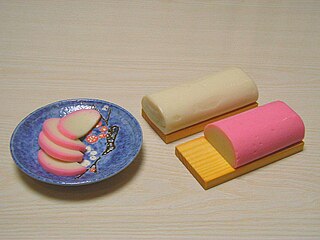 W
WKamaboko (蒲鉾:かまぼこ) is a type of cured surimi, a processed seafood product common in Japanese cuisine.
 W
WKroeung is a generic Khmer word for a number of spice/herb pastes that make up the base flavors of many Khmer dishes. Such dishes are often dubbed with the "-kroeung" suffix. Kroeung is traditionally made by finely chopping the ingredients and grinding them together using a heavy mortar and pestle although mechanical food processors can be used in modern kitchens. Various ingredients, depending on the dish and the taste of the cook, can be pounded into kroeung. The eight most commonly used are lemongrass, magrut lime zest and leaves, galangal, turmeric, garlic, shallots, dried red chillies and various rhizomes . This herbal paste is essential for preparing Khmer dishes in order to create the authentic flavour.
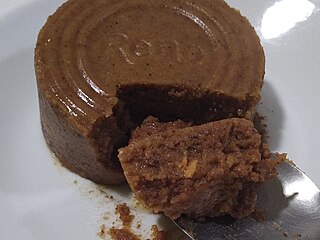 W
WLiver spread is a Filipino canned spread product made from pureed pork, beef, or chicken liver mixed with cereal and/or offal similar to the French pâté and German liverwurst. Liver spread is usually eaten as a filling for sandwich bread and an accompaniment to crackers but it is also used as an ingredient in dishes like lechon sauce and the Tagalog version of paksiw na lechon. It is also used in some households as an ingredient to some dishes e.g. caldereta and Filipino spaghetti.
 W
WLotus seed paste is a Chinese dessert ingredient made from dried lotus seeds. It is traditionally considered a luxurious ingredient.
 W
WMaple butter, also known as maple cream or maple spread, is a confection made from maple syrup, by heating the syrup to approximately 112 °C (234 °F), cooling it to around 52 °C (126 °F), and beating it until it reaches a smooth consistency. It is usually made from Grade A Light Amber syrup, and is a light tan color.
 W
WMarmite ( MAR-myte) is a savoury food spread made from yeast extract that was invented by German scientist Justus von Liebig and originally made in the United Kingdom. It is a by-product of beer brewing and is currently produced by British company Unilever. The product is notable as a vegan source of B vitamins, including supplemental vitamin B12. A traditional use is to spread it very thinly on buttered toast.
 W
WMarmite is a food spread produced in New Zealand by Sanitarium Health and Wellbeing Company and distributed in Australia and the Pacific. Marmite is made from yeast extract, a by-product of beer brewing. It is similar to the British Marmite, but the two products are made by different companies.
 W
WMarzipan is a confection consisting primarily of sugar, honey, and almond meal, sometimes augmented with almond oil or extract.
 W
WMiso is a traditional Japanese seasoning produced by fermenting soybeans with salt and kōji and sometimes rice, barley, seaweed, or other ingredients. The result is a thick paste used for sauces and spreads, pickling vegetables, fish, or meats, and mixing with dashi soup stock to serve as miso soup, a Japanese culinary staple. High in protein and rich in vitamins and minerals, miso played an important nutritional role in feudal Japan. Miso is still widely used in Japan, both in traditional and modern cooking, and has been gaining worldwide interest.
 W
WThe mung bean, alternatively known as the green gram, maash, moong, monggo, or munggo (Philippines), is a plant species in the legume family. The mung bean is mainly cultivated in East, Southeast and South Asia. It is used as an ingredient in both savoury and sweet dishes.
 W
WNgapi, formerly also spelled ngapee, nga-pee and gnapee, is a pungent paste made of either fish or shrimp in Burmese cuisine. Ngapi is usually made by fermenting fish or shrimp that is salted and ground then sundried. Like cheese, it can be distinguished based on main ingredient and regional origin. Ngapi can be distinguished by the type of fish used to make it. Ngapi can come from whole fish, from small fish or from prawns. Ngapi is a main ingredient of Lower Burmese cooking and is used as a condiment or additive in most dishes. Raw ngapi, with some exceptions, is not intended for direct consumption.
 W
WOxo is a brand of food products, including stock cubes, herbs and spices, dried gravy, and yeast extract. The original product was the beef stock cube, and the company now also markets chicken and other flavour cubes, including versions with Chinese and Indian spices. The cubes are broken up and used as flavouring in meals or gravy or dissolved into boiling water to produce a bouillon.
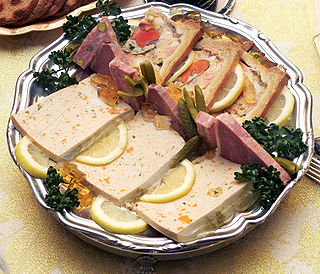 W
WPâté is a paste, pie or loaf filled with a forcemeat. Common forcemeats include ground meat from pork, poultry, fish or beef; fat, vegetables, herbs, spices and either wine or brandy.
 W
WPeanut butter is a food paste or spread made from ground, dry-roasted peanuts. It commonly contains additional ingredients that modify the taste or texture, such as salt, sweeteners, or emulsifiers. Peanut butter is consumed in many countries. The United States is a leading exporter of peanut butter and one of the largest consumers of peanut butter annually per capita. January 24 is National Peanut Butter Day in the United States.
 W
WPesto, or pesto alla genovese, is a sauce originating in Genoa, the capital city of Liguria, Italy. It traditionally consists of crushed garlic, European pine nuts, coarse salt, basil leaves, and hard cheese such as Parmigiano-Reggiano or Pecorino Sardo, all blended with olive oil.
 W
WPhanaeng, also spelled phanang, panang, and other variants) is a type of red Thai curry that is thick, salty and sweet, with a zesty makrut lime flavour. The earliest known mention of phanaeng appears in Mom Somchin Rachanupraphan's book Tamra Kap Khao (ตำรากับข้าว), published in 1890.
 W
WPlumpy'Nut is a peanut-based paste in a plastic wrapper for treatment of severe acute malnutrition manufactured by Nutriset, a French company. Removing the need for hospitalization, the 92-gram packets of this paste can be administered at home and allow larger numbers to be treated.
 W
WA potted meat food product is a food preserved by canning and consisting of various seasoned cooked meats, often puréed, minced, or ground, which is heat processed and sealed into small cans. This is different from potted meat, an older noncommercial method of preserving meat.
 W
WPrahok is a crushed, salted and fermented fish paste that is used in Cambodian cuisine as a seasoning or a condiment. It originated as a way of preserving fish during the months when fresh fish was not available in abundant supply. Because of its saltiness and strong flavor, it was used as an addition to many meals in Cambodian cuisine, such as soups and sauces. A Cambodian saying goes, "No prahok, no salt", referring to a dish that is of poor flavor or bland thus highlighting its essentiality in Cambodian cuisine. Prahok has a strong and distinct smell, earning the nickname "Cambodian cheese". Prahok is usually eaten as a main course with white rice and vegetable such as yardlong bean, cucumbers, and Thai eggplant.
 W
WRecado rojo or achiote paste is a popular blend of spices. It is now strongly associated with Mexican and Belizean cuisines, especially of Yucatán and Oaxaca. The spice mixture usually includes annatto, oregano, cumin, clove, cinnamon, black pepper, allspice, garlic, and salt. The annatto seeds dye the mixture red, and impart a distinctive red-orange color to the food.
 W
WRed bean paste or red bean jam, also called adzuki bean paste or anko, is a paste made of red beans, used in East Asian cuisine. The paste is prepared by boiling the beans, then mashing or grinding them. At this stage, the paste can be sweetened or left as it is. The color of the paste is usually dark red, which comes from the husk of the beans. In Korean cuisine, the adzuki beans can also be husked prior to cooking, resulting in a white paste. It is also possible to remove the husk by sieving after cooking, but before sweetening, resulting in a red paste that is smoother and more homogeneous.
 W
WSambal is a chilli sauce or paste, typically made from a mixture of a variety of chilli peppers with secondary ingredients such as shrimp paste, garlic, ginger, shallot, scallion, palm sugar, and lime juice. Sambal is an Indonesian loan-word of Javanese and Sundanese origin. It originated from the culinary traditions of Indonesia, and is also an integral part of the cuisines of Malaysia, Sri Lanka, Brunei and Singapore. It has also spread through overseas Indonesian populations to the Netherlands and Suriname.
 W
WSatsivi is a Georgian dish made from poultry such as turkey or chicken put into walnut sauce. The term satsivi is also used as a generic name for a variety of poultry made with the walnut sauce.
 W
WShrimp paste or prawn sauce is a fermented condiment commonly used in Southeast Asian and Southern Chinese cuisines. It is primarily made from finely crushed shrimp or krill mixed with salt, and then fermented for several weeks. They are either sold in their wet form or are sun-dried and either cut into rectangular blocks or sold in bulk. It is an essential ingredient in many curries, sauces and sambal. Shrimp paste can be found in many meals in Cambodia, Indonesia, Laos, Malaysia, Myanmar, the Philippines, Singapore, Thailand, and Vietnam. It is often an ingredient in dip for fish or vegetables.
 W
WSsamjang is a thick, spicy paste used with food wrapped in a leaf in Korean cuisine. The sauce is made of doenjang, gochujang, sesame oil, onion, garlic, green onions, and optionally brown sugar.
 W
WSunflower butter, also known as sunflower seed butter, is a food paste made from sunflower seeds. Sunflower butter is commonly used as a substitute for peanut butter when allergies are a concern.
 W
WSurimi is a paste made from fish or other meat. The term can also refer to a number of East Asian foods that use that paste as their primary ingredient. It is available in many shapes, forms, and textures, and is often used to mimic the texture and color of the meat of lobster, crab, grilled Japanese eel or shellfish.
 W
WSweet bean paste is a food ingredient used throughout East Asian cuisine, primarily as a filling for sweet desserts and pastries.
 W
WTahini or tahina is a Middle Eastern condiment made from toasted ground hulled sesame. It is served by itself or as a major ingredient in hummus, baba ghanoush, and halva.
 W
WThai curry refers both to dishes in Thai cuisine that are made with various types of curry paste and to the pastes themselves. A Thai curry dish is made from curry paste, coconut milk or water, meat, seafood, vegetables or fruit, and herbs. Curries in Thailand mainly differ from the curries in Indian cuisine in their use of ingredients such as herbs and aromatic leaves over a mix of spices.
 W
WTomato paste is a thick paste made by cooking tomatoes for several hours to reduce the water content, straining out the seeds and skins, and cooking the liquid again to reduce the base to a thick, rich concentrate. It is used to impart an intense tomato flavour to a variety of dishes, such as pasta, soups and braised meat.
 W
WVegemite is a thick, dark brown Australian food spread made from leftover brewers' yeast extract with various vegetable and spice additives. It was developed by Cyril Callister in Melbourne, Victoria in 1922.
 W
WYellow soybean paste is a fermented paste made from yellow soybeans, salt, and water. Yellow soybean paste is produced in China and is used primarily in Beijing cuisine and other cuisines of northern China.
 W
WYuzu koshō is a type of Japanese seasoning. It is a paste made from chili peppers, yuzu peel and salt, which is then allowed to ferment. It is usually used as a condiment for nabemono dishes, miso soup, and sashimi. The most famous types of yuzukoshō come from Kyushu, where it is a local specialty.